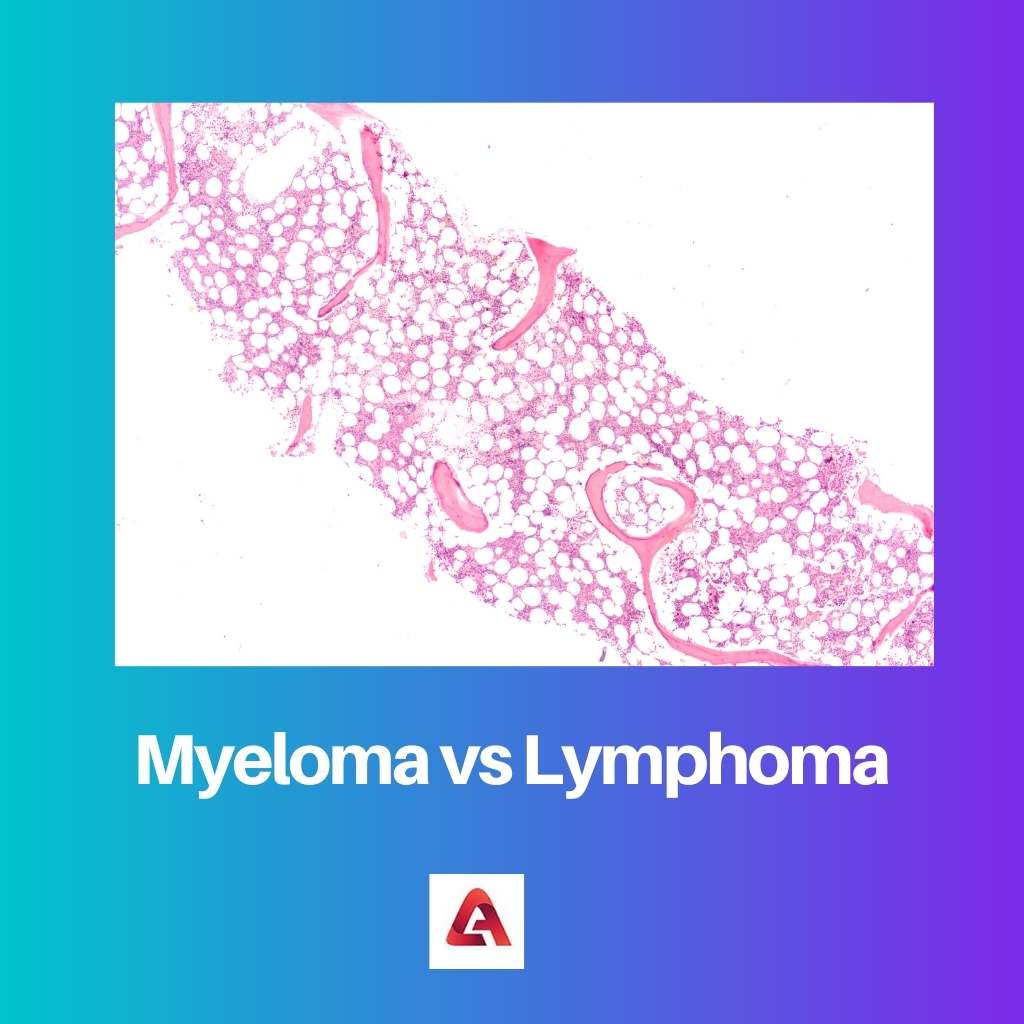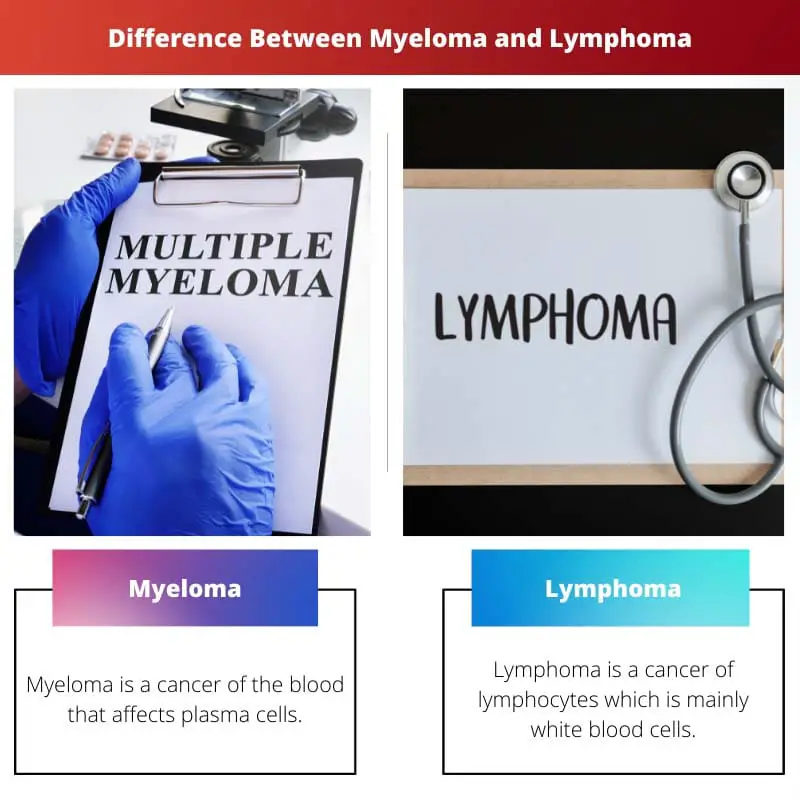Cancer is a broad term that includes a wide variety of types of cancer. Anyone can be diagnosed with cancer regardless of age, race, or gender.
Myeloma and Lymphoma are two categories of blood cancer that affect the blood cells. Myeloma affects the plasma cell that is present in the bone marrow, while lymphoma affects the lymphocytes.
Key Takeaways
- Myeloma is a cancer of plasma cells, while lymphoma affects lymphocytes.
- Myeloma primarily impacts bone marrow, whereas lymphoma involves the lymphatic system.
- Lymphoma is more common than myeloma, and treatments for the two cancers differ.
Myeloma vs Lymphoma
Myeloma is a cancer of the plasma cells, which are a type of white blood cell that produces antibodies to help fight infections. Lymphoma is a lymphatic system cancer, a network of vessels and tissues that help fight infections. Treatment for lymphoma depends on the type and stage of cancer.

Myeloma is a type of blood cancer affecting the plasma cells in the bone marrow. When plasma cells are affected or become cancerous, then these cells start growing abnormally and produce abnormal antibodies.
Bone pain and enlargement is the major and primary symptom of myeloma.
Lymphoma is also a type of cancer affecting the lymphatic system, consisting of lymphocytes (white blood cells).
This type of cancer is further classified into two types, namely Non- Hodgkin’s Lymphoma and Hodgkin’s Lymphoma, which is again further categorized into thirty and five subtypes, respectively.
Painless lymph nodes, swelling, and spleen are the primary symptoms that help to diagnose lymphoma.
Comparison Table
| Parameters of Comparison | Myeloma | Lymphoma |
|---|---|---|
| What is it | Myeloma is a cancer of the blood that affects plasma cells. | Lymphoma is a cancer of lymphocytes which is mainly white blood cells. |
| Risk Factor | Risk factors associated with this type of cancer include having a family history of myeloma, having obesity, having other plasma cell diseases, etc. | Risk factors associated with lymphoma include having bacterial infections, having weakened immune system, obesity, radiation exposure, family history of lymphoma, an autoimmune condition, etc. |
| Symptoms | Symptoms include dehydration, frequent infection, leg swelling, shortness of breath, kidney problems, weakened bone, bone pain, and many more. | Symptoms include fatigue, itching, night sweats, weight loss, abdomen swelling, enlargement of lymph nodes, bruising, and many more. |
| Treatment | Treatment options available for myeloma include chemotherapy, radiation therapy, immunomodulating agents, stem cell transplant, proteasome inhibitors, and surgery. | Treatment options available for lymphoma include stem cell transplant, immunotherapy, chemotherapy, and radiation therapy. |
| Classification | The classification of myeloma is the same. | Lymphoma is classified into various types and subtypes. |
What is Myeloma?
Myeloma is a type of blood cancer that is diagnosed by affecting plasma cells, which are present in the bone marrow. When plasma cells get affected, it starts multiplying abnormally and produce antibodies called paraprotein.
If myeloma affects multiple parts or places of the body, then it is considered multiple myeloma.
There are various symptoms of myeloma. Some of the major and primary symptoms include kidney damage, bone pain, and recurring infection. It also includes symptoms like breath shortness, weakness, swollen legs, dehydration, frequent urination, etc.
Myeloma can be diagnosed in various stages ranging from high, intermediate, to standard risk depending on the tumour’s genes. Different treatment is provided to the patient at different stages.
This includes chemotherapy, proteasome inhibitors, radiation therapy, stem cell transplants, surgery, and immunomodulation agents. The treatment or drug given to the patient depends on the age and how threatening the cancer stage is.
What is Lymphoma?
Lymphoma is cancer of the blood that affects the lymphatic system, which is composed of lymphocytes. Lymphocytes mainly consist of B and T cells, and each cell work specifically to protect the body from various diseases.
This type of cancer is classified into two types, namely Hodgkin and non-Hodgkin. These two types include different types of lymphocyte cells, and each responds differently at a different rate.
Major lymphoma symptoms include fever, weight loss, shortness of breath, night sweats, abdomen swelling, itching, etc.
Doctors suggest various tests to diagnose lymphoma. This includes chest X-rays, MRIs, blood tests, bone marrow aspiration, and molecular tests.
Treatment of this type of cancer varies from one stage to another. For non-Hodgkin lymphoma, radiotherapy, chemotherapy, targeted therapy, and immunotherapy are suggested.
For Hodgkin, on the other side, immunotherapy, radiation therapy, and chemotherapy are considered the main treatments.
Main Differences Between Myeloma and Lymphoma
- Myeloma and lymphoma are blood cancers that affect the body in one way or another. Myeloma is a cancer of plasma cells that are present in the bone marrow of the body. Lymphoma, on the other side, is cancer of lymphocytes which is categorized as white cells.
- Apart from the family history of the disease, there is a number of risk factors that directly or indirectly affect the individual. Risk factors associated with myeloma are obesity, having other plasma cell diseases, etc. Lymphoma, on the other side, has risk factors like bacterial infections, a weakened immune system, obesity, radiation exposure, an autoimmune condition, etc.
- Every disease has some major symptoms that help in diagnosing the disease effectively. Myeloma symptoms include dehydration, frequent infection, leg swelling, shortness of breath, kidney problems, weakened bone, and bone pain. Symptoms of lymphoma are fatigue, itching, night sweats, weight loss, abdomen swelling, enlargement of lymph nodes, bruising, and many more.
- Cancer treatment varies from patient to patient, depending on their age and stage diagnosed. Treatment options are available for myeloma include chemotherapy, radiation therapy, immunomodulating agents, stem cell transplant, proteasome inhibitors, and surgery. On the contrary, treatment options available for lymphoma include stem cell transplant, immunotherapy, chemotherapy, and radiation therapy.
- Myeloma is classified as similar. But lymphoma, on the other hand, is further classified into two major types, non-Hodgkin and Hodgkin, which are further categorized into subtypes.

- https://www.nature.com/articles/1702822
- https://acsjournals.onlinelibrary.wiley.com/doi/abs/10.1002/1097-0142(19880501)61:9%3C1782::AID-CNCR2820610910%3E3.0.CO;2-7

Interesting content. The detailed information provided about the symptoms and risk factors of myeloma and lymphoma is very informative. There are some great insights into the complexities of these blood cancers.
The detailed comparison between myeloma and lymphoma, from diagnosis to treatment, is incredibly helpful for individuals seeking information about these blood cancers. A reliable resource to gain knowledge about these conditions.
This article provides a comprehensive comparison between myeloma and lymphoma, including risk factors, symptoms, treatment, and classification. This helps bring clarity to the differences between the two types of blood cancer. Excellent source of information.
The categorization of symptoms and treatment options between myeloma and lymphoma is quite insightful. However, more research references to support the factual accuracy of the information presented would enhance its reliability.
Wow, this article is really enlightening. There’s so much to know about these types of cancer. I appreciate the comparison table provided, it makes it much easier to understand the differences. Great work!
The article lacks insight into the correlation of genetic predispositions and its impact on cancer development among individuals. There is a gap in addressing the genetic predisposition of myeloma and lymphoma within this informative material.